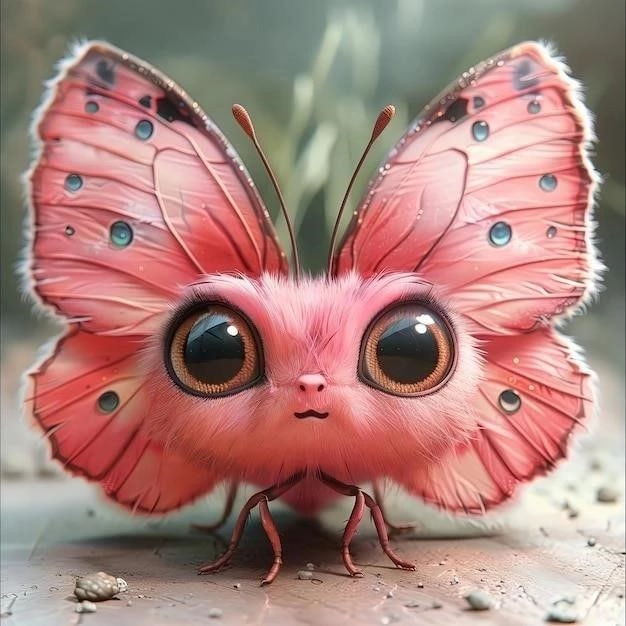The Pink Fairy Armadillo: An Overview
The pink fairy armadillo (Chlamyphorus truncatus), also known as the pichiciego, is the smallest species of armadillo. First described by Richard Harlan in 1825, this unique creature is endemic to the sandy plains, dunes, and dry grasslands of central Argentina. This solitary, desert-adapted animal is recognizable by its pale pink carapace, which attaches to its body by a thin membrane along its spine.
Measuring a mere 9-12 cm in length, the pink fairy armadillo is roughly the size of a hamster. Its small size, combined with its nocturnal habits and remarkable burrowing abilities, make it a rare and elusive creature. Though small, the pink fairy armadillo plays an important role in its ecosystem, aerating the soil and consuming insects and larvae.
Physical Characteristics and Adaptations
The pink fairy armadillo, true to its name, is strikingly adorned with a pale pink carapace, a stark contrast to the more muted tones of its larger relatives. This rosy hue is not just a quirk of nature; it serves a crucial purpose in the armadillo’s desert environment. The pink coloration, believed to be derived from blood vessels close to the shell’s surface, aids in thermoregulation. The blood vessels dilate and constrict, allowing the armadillo to adjust its body temperature by absorbing or releasing heat.

This remarkable adaptation is just one of many that allow the pink fairy armadillo to thrive in the arid plains and grasslands of Argentina. Measuring a mere 9-12 cm in length, excluding its tail, and weighing a scant 85-120 grams, it is the smallest armadillo species in the world. Its diminutive size, coupled with a streamlined, almost aerodynamic body shape, facilitates its movement through the dense sand and undergrowth.

Perhaps the most distinguishing feature of the pink fairy armadillo, aside from its rosy carapace, is the unique structure of its dorsal shell. Unlike the armor of other armadillo species, which is firmly attached to the body, the pink fairy armadillo’s shell is connected by a thin, flexible membrane running along its spine. This decoupled shell allows for remarkable flexibility, enabling the armadillo to contort itself into tight burrows and maneuver through narrow underground tunnels.
Its front limbs are equipped with powerful claws, perfectly adapted for digging and excavating its underground burrows. These burrows, often located at the base of ant and termite mounds, provide a stable microclimate, protecting the armadillo from the extremes of temperature and potential predators.

In addition to its physical adaptations, the pink fairy armadillo possesses a keen sense of smell and hearing, crucial for navigating its subterranean world and locating prey. Its small eyes, however, indicate a reliance on senses other than sight, a common trait amongst fossorial creatures. The pink fairy armadillo’s unique combination of physical characteristics and sensory adaptations make it a marvel of natural engineering, perfectly equipped for survival in the challenging environment it calls home.

Habitat and Distribution
The pink fairy armadillo (Chlamyphorus truncatus) is endemic to the central region of Argentina, meaning this is the only place in the world where it is found naturally. Its distribution spans a relatively small area, encompassing parts of the provinces of Mendoza, San Luis, Buenos Aires, La Pampa, and Santa Fe. Within this region, the pink fairy armadillo exhibits a preference for arid and semi-arid habitats characterized by specific soil types and vegetation.
The sandy plains, dunes, and dry grasslands within its range provide the ideal substrate for the pink fairy armadillo’s remarkable burrowing abilities. These loose, friable soils allow for easy excavation, enabling the armadillo to create intricate underground tunnels and chambers that provide refuge from predators and temperature extremes. The armadillo’s habitat is also characterized by sparse vegetation, predominantly consisting of drought-resistant grasses, shrubs, and cacti. This type of vegetation not only provides some degree of camouflage but also contributes to the armadillo’s diet. The roots and tubers of these plants, along with the occasional fallen fruit, supplement its primarily insectivorous diet.

The pink fairy armadillo is highly specialized for its unique environment, and its survival is inextricably linked to the preservation of these fragile ecosystems. Habitat loss and fragmentation, driven by agricultural expansion, overgrazing, and urbanization, represent significant threats to the species’ long-term survival. The pink fairy armadillo’s limited distribution, coupled with its specialized habitat requirements, makes it particularly vulnerable to environmental changes and habitat degradation.
Ongoing research and conservation efforts are crucial for understanding the full extent of the pink fairy armadillo’s range and identifying critical areas for protection. By studying its habitat preferences and the ecological factors that influence its distribution, conservationists can develop effective strategies for mitigating threats and ensuring the long-term survival of this remarkable and enigmatic creature.
Diet and Lifestyle
The pink fairy armadillo (Chlamyphorus truncatus), a master of adaptation to the arid plains of central Argentina, exhibits a lifestyle and diet perfectly suited to its subterranean world. Primarily insectivorous, this tiny creature relies on a diet consisting mainly of ants, termites, and their larvae. It navigates its underground realm using its highly developed senses of smell and hearing, sniffing out ant colonies and detecting the subtle vibrations of insect movement through the soil.
While ants and termites form the cornerstone of its diet, the pink fairy armadillo is known to exhibit a degree of dietary flexibility, supplementing its insectivorous fare with other food sources available in its arid environment. Roots, tubers, and worms provide additional nutrients, while fallen fruits and seeds offer a seasonal source of sustenance. This adaptability is crucial for survival in an environment where resources can be scarce and unpredictable.
The pink fairy armadillo’s fossorial lifestyle, characterized by its near-constant presence underground, is a testament to its remarkable adaptations for survival in a harsh and unforgiving landscape. Its powerful claws and streamlined body make it an exceptional digger, allowing it to create intricate burrows that provide shelter from predators and temperature extremes. These burrows are more than just simple shelters; they are microhabitats with stable temperatures and humidity levels, offering a refuge from the scorching heat of the Argentinian plains.
Primarily nocturnal, the pink fairy armadillo emerges from its burrow under the cover of darkness to forage for food, minimizing its exposure to predators and the harsh desert sun. Its solitary nature further reduces its visibility and minimizes competition for resources within its limited territory. Despite its small size and reclusive habits, the pink fairy armadillo plays an important role in its ecosystem. Its burrowing activity aerates the soil, promoting water infiltration and nutrient cycling, while its insectivorous diet helps to regulate insect populations.

Conservation Status and Threats

The pink fairy armadillo (Chlamyphorus truncatus), with its enchanting name and captivating appearance, belies a precarious conservation status. Classified as “Data Deficient” on the IUCN Red List, this enigmatic creature presents a significant challenge for conservationists due to its elusive nature and the limited data available on its population size and trends. However, the information gathered thus far paints a concerning picture, suggesting that the pink fairy armadillo faces a multitude of threats, primarily stemming from human activities that encroach upon its fragile habitat.
Habitat loss and fragmentation represent the most significant threats to the pink fairy armadillo’s long-term survival. The conversion of its native grasslands and plains for agricultural expansion, particularly for cattle ranching and soybean cultivation, leads to direct habitat destruction and fragmentation of populations. Overgrazing by livestock further degrades the soil, making it unsuitable for burrowing and reducing the availability of insect prey.
Urbanization and infrastructure development also contribute to habitat loss and fragmentation, with roads and settlements encroaching upon the armadillo’s range. Road mortality poses a significant threat, as the armadillos’ instinct to burrow when threatened often leads to collisions with vehicles. The illegal pet trade, fueled by the pink fairy armadillo’s unique appearance and rarity, also poses a potential threat, although the extent of its impact is difficult to quantify.
Climate change adds another layer of complexity to the conservation challenges facing the pink fairy armadillo. Changes in precipitation patterns and increasing temperatures in its already arid environment could exacerbate drought conditions, impacting the availability of food and water sources. The pink fairy armadillo’s highly specialized adaptations, while advantageous in its current environment, may limit its ability to adapt to rapid environmental changes.










